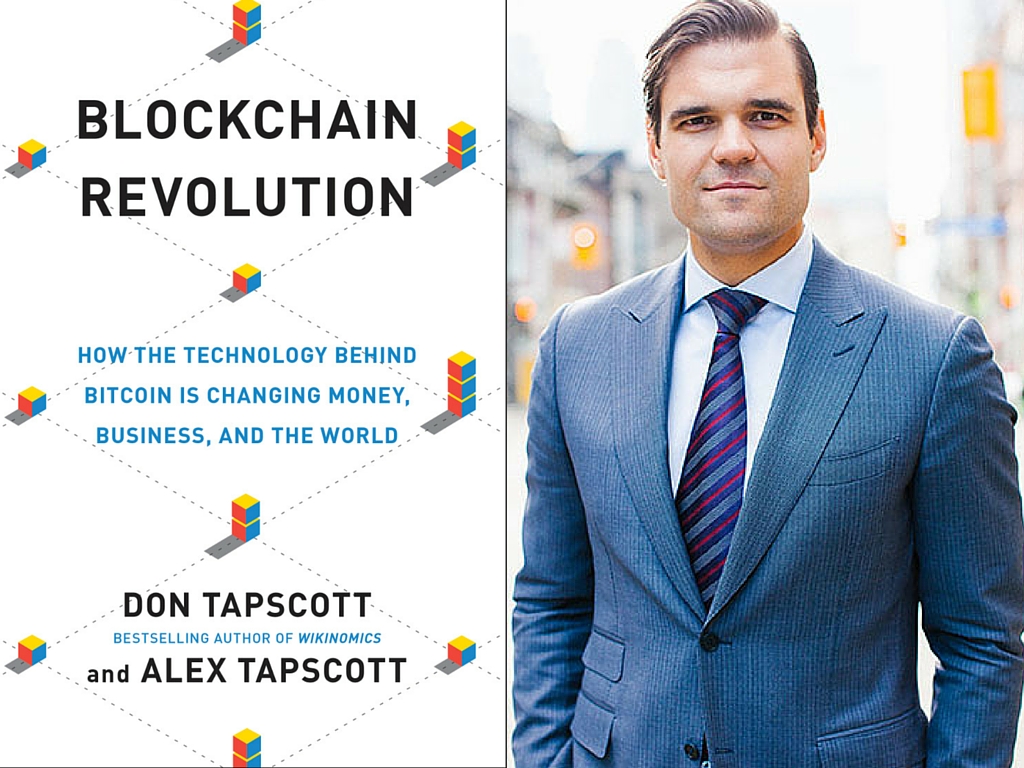25 years and counting: How one agency has evolved alongside the financial industry
[podcast] Investing in growth-stage fintech with Long Ridge’s Kevin Bhatt
The changing demands on a technology consultant in today’s finance industry
Marketing financial services to millennials: A roundup
Capgemini’s Bill Sullivan on how the finserv market has changed over the past 7 years and where it’s headed
5 trends we’re watching this week
Why senior financial professionals should care about bitcoin and blockchain technologies
We have entered a period of what Google’s chief economist, Hal Varian, likes to call “combinatorial innovation”; a term for when many factors combine to drive the creation of new inventions. Today, the key factors sparking innovation are transparency of information, speed and connectivity, open source software and APIs which enable the development of layered ecosystems of applications. One such innovation that was created by the coming together of these factors is the blockchain.
What is blockchain and how can it benefit why should finance professionals care?

The blockchain serves as an append-only data store of transactions that has two components: a replicated ledger and a distributed database. The database is stored and synchronized by all parties (referred to as nodes) to a shared ledger within the blockchain network. Bitcoin, a digital currency that uses blockchain technology, is used to track money transactions but it can also track the exchange of other assets including financial securities or data related to an individual’s identity such as IDs or proofs of address, for example.
Blockchain is far from being a passing fad and finance professionals need to become familiar with the concept because, in time, it is likely to fundamentally overhaul the way financial transactions are made. Indeed, once it begins to be adopted more widely, it will revolutionize the structure of the financial services industry as the technology eliminates the need for trusted intermediaries such as clearing houses. Financial institutions that are not exploring the opportunities that blockchain creates will lag behind in terms of knowledge and strategic options, particularly in relation to efficiency and cost saving opportunities. Further, front office systems automation, as well as the simplification and standardization of back office systems, are areas that are likely to take place as a result of blockchain technology implementation. Financial institutions, therefore, have duty to look to innovative technology solutions the adoption of which may be more imminent than is currently understood.
Where do you see blockchain making an impact within finance? When?
GreySpark is currently exploring seven capital markets’ use cases for the blockchain:
- Payments and remittance
- know-your-client or anti-money laundering
- digitized financial instruments
- regulatory reporting
- clearing and settlement
- reconciliation
- smart contracts applications for servicing of financial instruments
The most pertinent use cases, in GreySpark’s opinion, are in clearing and settlement, reconciliation and the use of smart contracts.
Smart contracts are event-driven computer programs that allow the automatic verification of the transactional governance (terms and conditions) between two counterparties, eliminating the need for a central arbitrator. Smart contracts can be added to blockchain-based transactions to deal with the legal aspects of a commercial agreement.
The use of blockchain technology will mean that the execution, clearing and settlement of a trade can occur quasi-instantly, lowering post-trade latency and reducing counterparty exposures. Blockchain transactions are quicker, less expensive and involve fewer intermediaries such as brokers and central securities depositary that the traditional approach.
Blockchain technology can also be used to simplify the reconciliation of trades as this approach does not require the comparison and rectification of ledgers held by different institutions. In the case of a private blockchain, where participants gain permissioned access to the database, institutions are able to meet their reconciliatory obligations without actually having to reconcile with other institutions, thanks to the replicated and synchronized nature of the blockchain ledger.
It will, however, take some time for the scale of blockchain applications to reach a critical size. As it is at an early stage of development, the excitement it is generating in the industry is a normal thing, but the first step into this new world, such as investing in blockchain start-ups for example, must be taken with great care: lucidity and a comprehension of the implications will be a key success factor in this area.
Can you give an example of a block chain initiative that you’re currently working on that demonstrates where this market is headed?
While the applications for Distributed Ledger Technologies for each use case are equally valid, some of the use cases have already proven to be stronger than others. These offerings are capable of either disrupting or replacing existing trade-lifecycle technology systems and processes in banks and financial markets infrastructure providers such as clearinghouses and exchanges.
GreySpark believes a starting point for the industry should be to focus on developing ways of employing blockchain technology to improve the process of transferring securities by enabling market participants to connect on a peer-to-peer (P2P) basis without the intermediation of brokers. This would remove friction and allow the execution, clearing and settlement to occur at a trade-entry level, quasi-instantaneously.
When trying to turn the transfer of securities into a real P2P blockchain-based system, the challenge lies in taking the whole trade lifecycle into consideration to ensure the process is seamless. For instance, from the technology perspective, this includes being able to digitize securities and map share registers on the blockchain. Another challenge is to ensure the blockchain technology is scalable enough to deal with tomorrow’s transaction volumes. To address this, companies such as SETL are developing solutions to extend bandwidths and increase block capacities.
What does 2016 have in store for blockchain?
In 2016, people will begin to focus on, not only defining proof of concepts, but on the development of operational and productive applications. A carefully investigated proof of concept will enable firms to identify vendors that are right contenders for executing their blockchain program.
Also, increasing numbers of financial institutions will reach out to consultancies like GreySpark to help them to adapt to innovative technologies, assess emergent players and understand the risks associated with the new technology. Clients will be equipped with strategic plans to help them both understand and gain competitive advantage of the evolving technology environment. To address emerging trends and face innovation challenges in the Capital Markets industry, major financial institutions need help in deciding whether they should build in-house systems, collaborate with existing key players or invest in or directly acquire them. Ignoring the new concepts and innovations is an option financial institutions can no longer afford.
William Benattar
William Benattar is a member of GreySpark’s fintech advisory team. By maintaining a comprehensive view of the fintech arena, William assists GreySpark in helping start-up firms enter the marketplace; advises private equity houses on financial technology due diligence; and advises buyside and sellside clients on the development of strategic and innovative projects . Prior to joining GreySpark, William worked for Kantox in the business and product development team, focusing on strategy developments of FX systems. While being student ambassador for Google, William has spearheaded initiatives aimed at helping SMEs develop and implement their digital strategies. William is an existing mentor at the London-based accelerator program — Startupbootcamp Fintech — advising start-ups on product development, roadmapping and fundraising avenues.
GreySpark Partners
GreySpark is a business and technology consultancy that specialises in mission-critical areas of the Financial Markets industry with offices in London, New York, Hong Kong, Sydney and Edinburgh. GreySpark has expertise in Electronic Trading, Risk and Trade Management, Operations and Data Management and provides Business and Financial Technology Consulting services to buyside and sellside businesses as well as exchanges, market data providers, Independent Software Vendors and technology makers.
GreySpark recently published a report entitled The Blockchain: Capital Markets Use Cases.
Photo credit: Marko via VisualHunt / CC BY
[podcast] Uberization of finance? Ron Shevlin on the bank of the future

If you listen to NPR, you’ll sometimes hear a recording artist, someone like Lyle Lovett, referred to as “an artist’s artist”. Meaning, an artist that other people of the same craft can appreciate and love.
Our guest on this episode of the Tradestreaming Podcast is an analyst’s analyst. For the past 25 years, Ron Shevlin’s worked with the leading financial services, consumer products, retail, and manufacturing firms in the world. Ron’s the Director of Research at Cornerstone Advisors, a consulting firm to the banking and credit union industries, where he specializes in retail banking issues including sales and marketing technologies, customer and marketing analytics, social media, customer experience and consumer behavior. He was previously at Aite and Forrester covering the financial services space.
Most importantly for us, he’s the author of weekly articles he calls Snarketing published on the Financial Brand website that combine his keen eye for trends and opportunities for growth in the financial services space with his great sense of humor. It’s a must read for me and I hope it will become part of your reading list, too.
Listen to the FULL episode
In this episode, we:
- explore whether financial services is truly becoming uberized
- dive deeper into Ron’s vision for the future of financial services which he describes as the industry’s migration from product providers to a platform or ecosystem of financial services much like Amazon’s platform for ecommerce
MORE RESOURCES
- Snarketing (Ron’s archive)
- Cornerstone Advisors (Ron’s firm)
EVEN MORE RESOURCES
Photo credit: COMSALUD via Visual hunt / CC BY
An ex-Uber marketing pro weighs in on the Uberization of money debate
[dropcap size=big]W[/dropcap]hile the stock market opened 2016 with a loud plop, the hottest companies continue to be technology startups. Atop this pile sits Uber. Uber has become synonymous in tech circles for how easy buying things really can be and how enjoyable the experience can be, as well. If the taxi industry can be Uber-ized, the thinking goes, so can many large industries that have similarly been slow to change.
This conversation hit finance circles when the WSJ ran a story about how slow the finance industry has traditionally been in adopting best practices that have influenced the buying cycle in other industries. According to the article’s author, Zachary Karabell, head of global strategy at Envestnet, finance is indeed now undergoing its own Uber process. Not overnight or over weeks and months, but over the next few years, major parts of finance will undergo technology-driven disruption. And this change is being driven by fintech startups, like Wealthfront, EquityZen, Loyal3, and ZestFinance.
Whatever the risks, however, the Uberization of finance is no fad or stunt. Many of today’s startups may implode, as most do, but the spread and democratization of capital—and the proliferation and analysis of data—are irresistible trends. They will offer new opportunities to millions of people, entrepreneurs and investors alike. They also will unlock a vast amount of money, energy and talent, and to that we simply should say, bring it on.
Not everyone buys this line of thinking. Cornerstone Advisors’ Ron Shevlin explains that there isn’t really a parallel to the financial industry because this whole discussion is based on a misunderstanding of what Uber has really done. Uber pursued a consolidation strategy in a highly fragmented industry. The WSJ cites marketplace lending and crowdfunding as examples of uberization but rather than consolidate, these new forms of finance add to the fragmentation of the finance industry.
An Uber exec weighs in
Upstart, an online lender targeting millennial borrowers, is typically used as an example of the disruptive change that’s happening in finance. In order to lend to young adults, Upstart had to turn traditional lending models on their heads, as many of these FICO-like credit scores rely on historical data. As young people find their places in the gig economy, it’s not easy for them to get loans. Upstart’s forward-looking models are trying to change that. Young borrowers don’t have very much credit history, so Upstart uses other inputs to determine creditworthiness for its customers.
Mike Osborn joined the startup finance company recently as the company’s first CMO. Hailing from the marketing team at Uber, Mike joins a firm that’s generated $240M in originations in 18 months since it launched, averaging 25% month to month growth since inception (you can listen to Tradestreaming’s interview with Upstart founder and ex-Googler David Girouard below).
Osborn has a quick 3 point questionnaire when testing for Uberization:
- Is this an industry ripe for disruption?
- Who’s the disruptor?
- How will it be disrupted?
Finance fits this model, and to Osborn, much of the change is going to happen from the bottom up — with changes in consumer usage patterns brought about by top UI/UX in new finance apps and platforms. “When you think of what drives user experiences, in Upstart’s case, it’s about having better holistic models, better rates, different options — all with the view that we’re helping our users out of a jam,” Osborn explained.
In this vein, next generation finance tools should resonate with users and generate the same reactions as other apps residing on their smart phones. Why shouldn’t users have the same visceral responses to their banking apps that they do to their transportation apps?
“When your target audience are millennials, they live and breathe online and they do it in a community-driven way. Financial service providers need to find ways to get their users financially fit and package it into a shareable experience and celebrated event — the same way getting physically fit is. When someone loses a lot of weight and gets in shape, they take a before-and-after picture and post it socially. I can imagine the same thing happening before and after a difficult credit card situation.”
Growth hacking new accounts online and offline
Perhaps ironically, many of today’s online financial services startups rely on offline methods to acquire new customers. It’s especially acute when it comes to landing new borrowers, as two of the largest online consumer lenders, Lending Club and Prosper, each send tens of millions of offers via snail mail every month. Upstart’s Osborn embraces both online and offline acquisition marketing.
“When we think about where we’re going to find our next customers, we’re definitely looking at the offline opportunity. We’ve been positively surprised in volume and profitability with offline channels. When you get an email offer to refinance your debt, it’s pretty easy to ignore it. But when you get your credit card statement in the mail and a couple of days later, receive an offer to help pay it off, the offer has relevance and timeliness when it comes via direct mail.”
Same goes for social media marketing. Osborn claims that a Facebook response is either immediate or it disappears into the ether. That’s not to say Facebook isn’t fertile ground to message new prospects — it just needs to work quickly. Same goes for Google and search engine marketing. “The economics on Google work but we’ve been most positively surprised with direct mail,” Osborn reasoned.
If finance is being Uberized, where’s the pressure coming from?
It’s debatable whether the disruptive change everyone’s talking about is supply-side or demand-side driven. Osborn thinks it’s actually a confluence of factors that’s enabling the next generation of financial services, technologies, and apps racing to get a foothold with today’s customers.
- Consumer-led: The changes happening in the industry right now are implicitly lead by the consumer. People are demanding change. When every experience looks like an Uber experience, you get what you want and begin to expect more. You don’t want to have to go through all the hoops and paperwork associated with traditional financial services.
- Technology-driven: A lot of the change that’s happening in online lending is coming from changes in capabilities. Now, at Upstart, the firm has the power to make credit decisions using so many different signals — like what grades a prospective borrower got in college. These borrowers were previously shut out of the market if they were judged solely on historical credit models.
Osborn believes it takes a new type of company and leadership to be able to compete today — both require an understanding of big data and large systems. “When I first met with Dave and the rest of the leadership team, founded by Googlers, I saw they understood the power of taking in all that data and making wise and powerful decisions, like extending credit, with it. There’s a reason we have such good ratings on CreditKarma and high NPS scores with our customers.”
Whether financial services are actually being Uber-ized misses what’s really going on. Led by technology advances and driven by customer demand, startups and incumbent institutions are changing the way users interact with money.
Photo credit: FamZoo via Visual Hunt / CC BY-SA














